
Other brands and names are the property of their respective owners
Information in this document is provided in connection with Intel products Intel assumes no liability whatsoever including infringement of any patent or
copyright for sale and use of Intel products except as provided in Intel's Terms and Conditions of Sale for such products Intel retains the right to make
changes to these specifications at any time without notice Microcomputer Products may have minor variations to this specification known as errata
September 1994
COPYRIGHT
INTEL CORPORATION 1995
Order Number 272267-004
8XC196NT
CHMOS MICROCONTROLLER WITH
1 MBYTE LINEAR ADDRESS SPACE
Y
20 MHz Operation
Y
High Performance CHMOS 16-Bit CPU
Y
Up to 32 Kbytes of On-Chip OTPROM
Y
Up to 1 Kbyte of On-Chip Register RAM
Y
Up to 512 Bytes of Internal RAM
Y
Register-Register Architecture
Y
4 Channel 10-Bit A D with Sample Hold
Y
37 Prioritized Interrupt Sources
Y
Up to Seven 8-Bit (56) I O Ports
Y
Full Duplex Serial I O Port
Y
Dedicated Baud Rate Generator
Y
Interprocessor Communication Slave
Port
Y
Selectable Bus Timing Modes for
Flexible External Memory Interfacing
Y
Oscillator Fail Detection Circuitry
Y
High Speed Peripheral Transaction
Server (PTS)
Y
Two Dedicated 16-Bit High-Speed
Compare Registers
Y
10 High Speed Capture Compare (EPA)
Y
Full Duplex Synchronous Serial I O
Port (SSIO)
Y
Two Flexible 16-Bit Timer Counters
Y
Quadrature Counting Inputs
Y
Flexible 8- 16-Bit External Bus
(Programmable)
Y
Programmable Bus (HOLD HLDA)
Y
1 4 ms 16 x 16 Multiply
Y
2 4 ms 32 16 Divide
Y
68-Pin Package
Device
Pins Package
OTPROM
Reg
Code
Address
I O
EPA
A D
RAM
RAM
Space
8XC196NT
68P PLCC
32K
1K
512
1 Mbyte
56
10
4
X
e
7 OTPROM Device
X
e
0 ROMLESS
The 8XC196NT 16-bit microcontroller is a high performance member of the MCS
96 microcontroller family
The 8XC196NT is an enhanced 8XC196KR device with 1 Mbyte of linear address space 1000 bytes of
register RAM 512 bytes of internal RAM 20 MHz operation and an optional 32 Kbytes of OTPROM Intel's
CHMOS III-E process provides a high performance processor along with low power consumption
Ten high-speed capture compare modules are provided As capture modules event times with 200 ns resolu-
tion can be recorded and generate interrupts As compare modules events such as toggling of a port pin
starting an A D conversion pulse width modulation and software timers can be generated Events can be
based on the timer or up down counter

8XC196NT
272267 � 1
Figure 1 8XC196NT Block Diagram
PROCESS INFORMATION
This device is manufactured on P629 5 a CHMOS
III-E process Additional process and reliability infor-
mation is available in Intel's
Components Quality
and Reliability Handbook
Order Number 210997
Table 1 Thermal Characteristics
Package
i
JA
i
JC
Type
PLCC
36 5 C W
13 C W
All thermal impedance data is approximate for static
air conditions at 1W of power dissipation Values will
change depending on operation conditions and ap-
plication See the Intel
Packaging Handbook
(order
number 240800) for a description of Intel's thermal
impedance test methodology
272267 � 2
EXAMPLE
N87C196NT is 68-Lead PLCC OTPROM
For complete package dimensional data refer to the Intel Packaging Handbook (Order Number 240800)
Figure 2 The 8XC186NT Familiy Nomenclature
2

8XC196NT
8XC196NT Memory Map
Address
Description
(Note 7)
FFFFFFH
External Memory
FFA000H
FF9FFFH
Internal OTPROM or External Memory (Determined by EA Pin)
FF2080H
RESET at FF2080H
FF207FH
Reserved Memory (Internal OTPROM or External Memory)
FF2000H
(Determined by EA Pin)
FF1FFFH
External Memory
FF0600H
FF05FFH
Internal RAM (Identically Mapped into 00400H � 005FFH)
FF0400H
FF03FFH
External Memory
FF0100H
FF00FFH
Reserved for ICE
FF0000H
FEFFFFH
External Memory for future devices
100000H
FFFFFH
984 Kbytes External Memory
00A000H
009FFFH
Internal OTPROM or External Memory (Note 1)
002080H
00207FH
Reserved Memory (Internal OTPROM or External Memory)
002000H
(Notes 1 3 and 6)
001FFFH
Memory Mapped Special Function Registers (SFR's)
001FE0H
001FDFH
Internal Special Function Registers (SFR's) (Note 5)
001F00H
001EFFH
External Memory
000600H
0005FFH
Internal RAM
000400H
(Address with Indirect or Indexed Modes)
0003FFH
Upper Register File (Address with Indirect or
Register RAM
Indexed Modes or through Windows ) (Note 2)
000100H
*
0000FFH
Register RAM
Lower Register File
000018H
(Address with Direct
000017H
CPU SFR's
Indirect or Indexed
000000H
*
Modes ) (Notes 2 4)
NOTES
1 These areas are mapped internal OTPROM if the REMAP bit (CCB2 2) is set and EA
e
5V Otherwise they are external
memory
2 Code executed in locations 00000H to 003FFH will be forced external
3 Reserved memory locations must contain 0FFH unless noted
4 Reserved SFR bit locations must be written with 0
5 Refer to 8XC196NT User's Guide and Quick Reference for SFR descriptions
6 WARNING The contents or functions of reserved memory locations may change with future revisions of the device
Therefore a program that relies on one or more of these locations may not function properly
7 The 8XC196NT internally uses 24 bit address but only 20 address lines are bonded out allowing 1 Mbyte external
address space
3
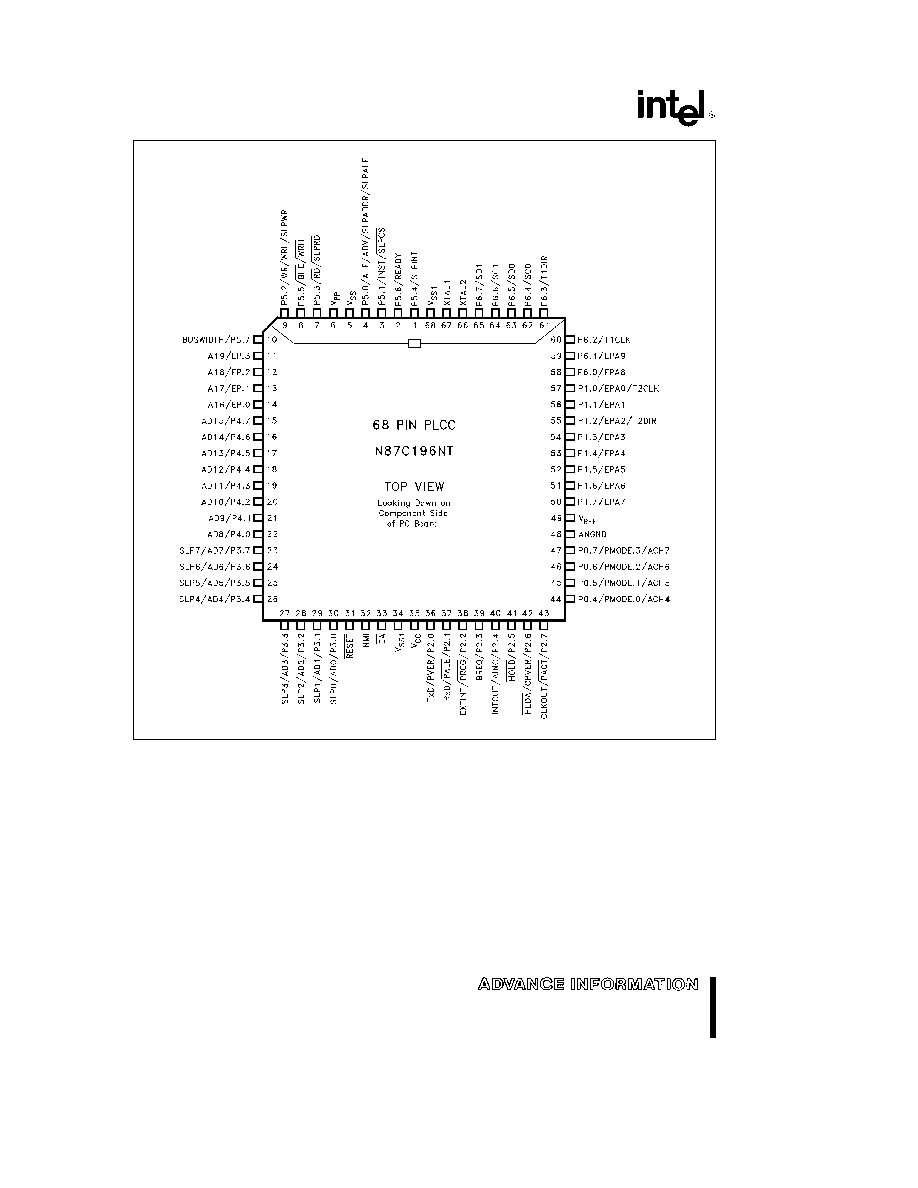
8XC196NT
272267 � 3
Figure 3 68-Pin PLCC Package Diagram
4
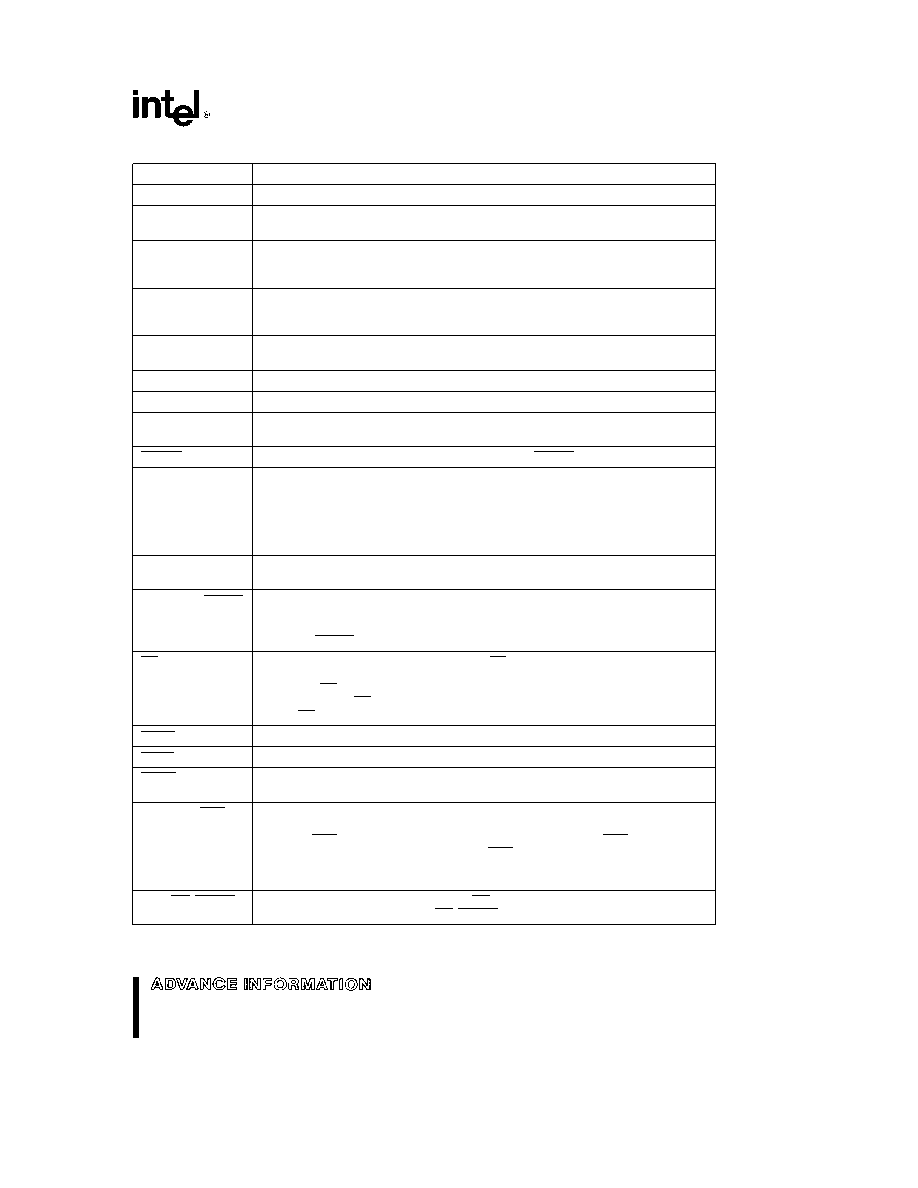
8XC196NT
PIN DESCRIPTIONS
Symbol
Name and Function
V
CC
Main supply voltage (a5V)
V
SS
V
SS1
V
SS1
Digital circuit ground (0V) There are multiple V
SS
pins all of which MUST be
connected
V
REF
Reference for the A D converter (a5V) V
REF
is also the supply voltage to the
analog portion of the A D converter and the logic used to read Port 0 Must be
connected for A D and Port 0 to function
V
PP
Programming voltage for the OTPROM parts It should be a12 5V for programming
It is also the timing pin for the return from powerdown circuit Connect to V
CC
if
powerdown not being used
ANGND
Reference ground for the A D converter Must be held at nominally the same
potential as V
SS
XTAL1
Input of the oscillator inverter and the internal clock generator
XTAL2
Output of the oscillator inverter
P2 7 CLKOUT
Output of the internal clock generator The frequency is
the oscillator frequency
It has a 50% duty cycle Also LSIO pin
RESET
Reset input to and open-drain output from the chip RESET has an internal pullup
P5 7 BUSWIDTH
Input for bus width selection If CCR bit 1 is a one and CCR1 bit 2 is a one this pin
dyamically controls the Buswidth of the bus cycle in progress If BUSWIDTH is low
an 8-bit cycle occurs if BUSWIDTH is high a 16-bit cycle occurs If CCR bit 1 is ``0''
and CCR1 bit 2 is ``1'' all bus cycles are 8-bit if CCR bit 1 is ``1'' and CCR1 bit 2 is
``0'' all bus cycles are 16-bit CCR bit 1 e ``0'' and CCR1 bit 2 e ``0'' is illegal Also
an LSIO pin when not used as BUSWIDTH
NMI
A positive transition causes a non maskable interrupt vector through memory
location 203EH
P5 1 INST SLPCS
Output high during an external memory read indicates the read is an instruction
fetch INST is valid throughout the bus cycle INST is active only during external
memory fetches during internal OTPROM fetches INST is held low Also LSIO when
not INST SLPCS is the Slave Port Chip Select
EA
Input for memory select (External Access) EA equal to a high causes memory
accesses to locations 0FF2000H through 0FF9FFFH to be directed to on-chip
OTPROM EA equal to a low causes accesses to these locations to be directed to
off-chip memory EA e a12 5V causes execution to begin in the Programming
Mode EA is latched at reset
HOLD
Bus Hold Input requesting control of the bus
HLDA
Bus Hold acknowledge output indicating release of the bus
BREQ
Bus Request output activated when the bus controller has a pending external
memory cycle
P5 0 ALE ADV
Address Latch Enable or Address Valid output as selected by CCR Both pin
options provide a latch to demultiplex the address from the address data bus When
SLPADDR
the pin is ADV it goes inactive (high) at the end of the bus cycle ADV can be used
SLPALE
as a chip select for external memory ALE ADV is active only during external
memory accesses Also LSIO when not used as ALE SLPADDR is the Slave Port
Address Control Input and SLPALE is the Slave Port Address Latch Enable Input
P5 3 RD SLPRD
Read signal output to external memory RD is active only during external memory
reads or LSIO when not used as RD SLPRD is the Slave Port Read Control Input
5

8XC196NT
PIN DESCRIPTIONS
(Continued)
Symbol
Name and Function
P5 2 WR WRL SLPWR
Write and Write Low output to external memory as selected by the CCR WR
will go low for every external write while WRL will go low only for external
writes where an even byte is being written WR WRL is active during external
memory writes Also an LSIO pin when not used as WR WRL SLPWR is the
Slave Port Write Control Input
P5 5 BHE WRH
Byte High Enable or Write High output as selected by the CCR BHEe0
selects the bank of memory that is connected to the high byte of the data bus
A0e0 selects that bank of memory that is connected to the low byte Thus
accesses to a 16-bit wide memory can be to the low byte only (A0e0
BHEe1) to the high byte only (A0e1 BHEe0) or both bytes (A0e0
BHEe0) If the WRH function is selected the pin will go low if the bus cycle is
writing to an odd memory location BHE WRH is only valid during 16-bit
external memory read write cycles Also an LSIO pin when not BHE WRH
P5 6 READY
Ready input to lengthen external memory cycles for interfacing with slow or
dynamic memory or for bus sharing If the pin is high CPU operation continues
in a normal manner If the pin is low prior to the falling edge of CLKOUT the
memory controller goes into a wait state mode until the next positive transition
in CLKOUT occurs with READY high When external memory is not used
READY has no effect The max number of wait states inserted into the bus
cycle is controlled by the CCR CCR1 Also an LSIO pin when READY is not
selected
P5 4 SLPINT
Dual function I O pin As a bidirectional port pin or as a system function The
system function is a Slave Port Interrupt Output Pin
P6 2 T1CLK
Dual function I O pin Primary function is that of a bidirectional I O pin
however it may also be used as a TIMER1 Clock input The TIMER1 will
increment or decrement on both positive and negative edges of this pin
P6 3 T1DIR
Dual function I O pin Primary function is that of a bidirectional I O pin
however it may also be used as a TIMER1 Direction input The TIMER1 will
increment when this pin is high and decrements when this pin is low
PORT1 EPA0 � 7
Dual function I O port pins Primary function is that of bidirectional I O System
function is that of High Speed capture and compare EPA0 and EPA2 have yet
P6 0 � 6 1 EPA8 � 9
another function of T2CLK and T2DIR of the TIMER2 timer counter
PORT 0 ACH4 � 7
4-bit high impedance input-only port These pins can be used as digital inputs
and or as analog inputs to the on-chip A D converter These pins are also
used as inputs to OTPROM parts to select the Programming Mode
P6 3 � 6 7 SSIO
Dual function I O ports that have a system function as Synchronous Serial I O
Two pins are clocks and two pins are data providing full duplex capability
PORT 2
8-bit multi-functional port All of its pins are shared with other functions
PORT 3 and 4
8-bit bidirectional I O ports with open drain outputs These pins are shared
with the multiplexed address data bus which has strong internal pullups
EPORT
8-bit bidirectional standard and I O port These bits are shared with the
extended address bus A16 � A19 Pin function is selected on a per pin basis
INTOUT
Interrupt Output This active-low output indicates that a pending interrupt
requires use of the external bus
SLP0 � SLP7
Slave Port Address Data Bus
6

8XC196NT
ABSOLUTE MAXIMUM RATINGS
Storage Temperature
b
60 C to a150 C
Voltage from V
PP
or EA to
V
SS
or ANGND
b
0 5V to a13 0V
Voltage from Any Other Pin
to V
SS
or ANGND
b
0 5 to a7 0V
This includes V
PP
on ROM and CPU devices
Power Dissipation
0 5W
NOTICE This data sheet contains information on
products in the sampling and initial production phases
of development The specifications are subject to
change without notice Verify with your local Intel
Sales office that you have the latest data sheet be-
fore finalizing a design
WARNING Stressing the device beyond the ``Absolute
Maximum Ratings'' may cause permanent damage
These are stress ratings only Operation beyond the
``Operating Conditions'' is not recommended and ex-
tended exposure beyond the ``Operating Conditions''
may affect device reliability
OPERATING CONDITIONS
Symbol
Parameter
Min
Max
Units
T
A
Ambient Temperature Under Bias
0
a
70
C
V
CC
Digital Supply Voltage
4 50
5 50
V
V
REF
Analog Supply Voltage
4 50
5 50
V
F
OSC
Oscillator Frequency
4
20
MHz (Note 4)
NOTE
ANGND and V
SS
should be nominally at the same potential
DC CHARACTERISTICS
(Under Listed Operating Conditions)
Symbol
Parameter
Min
Typ
Max
Units
Test Conditions
I
CC
V
CC
Supply Current
90
mA
XTAL1
e
20 MHz
V
CC
e
V
PP
e
V
REF
e
5 5V
I
REF
A D Reference Supply Current
5
mA
(While device in Reset)
I
IDLE
Idle Mode Current
40
mA
XTAL1
e
20 MHz
V
CC
e
V
PP
e
V
REF
e
5 5V
I
PD
Powerdown Mode Current
(6)
50
75
m
A
V
CC
e
V
PP
e
V
REF
e
5 5V
(11)
V
IL
Input Low Voltage (all pins)
b
0 5V
0 3 V
CC
V
For PORT0
(10)
V
IH
Input High Voltage
0 7 V
CC
V
CC
a
0 5
V
For PORT0
(10)
V
IH1
Input High Voltage XTAL1
0 7 V
CC
V
CC
a
0 5
V
XTAL1 Input Pin Only
(1)
V
IH2
Input High Voltage on RESET
0 7 V
CC
V
CC
a
0 5
V
RESET input pin only
V
OL
Output Low Voltage
0 3
V
I
OL
e
200 mA
(3 5)
(Outputs Configured as
0 45
V
I
OL
e
3 2 mA
Complementary)
1 5
V
I
OL
e
7 0 mA
V
OH
Output High Voltage
V
CC
b
0 3
V
I
OH
e b
200mA
(3 5)
(Outputs Configured as
V
CC
b
0 7
V
I
OH
e b
3 2 mA
Complementary)
V
CC
b
1 5
V
I
OH
e b
7 0 mA
I
LI
Input Leakage Current (Std Inputs)
g
10
m
A
V
SS
k
V
IN
k
V
CC
I
LI1
Input Leakage Current (Port 0)
g
3
m
A
V
CC
k
V
IN
k
V
REF
I
IL
Logical 0 Input Current
b
70
m
A
V
IN
e
0 45V
(1)
7
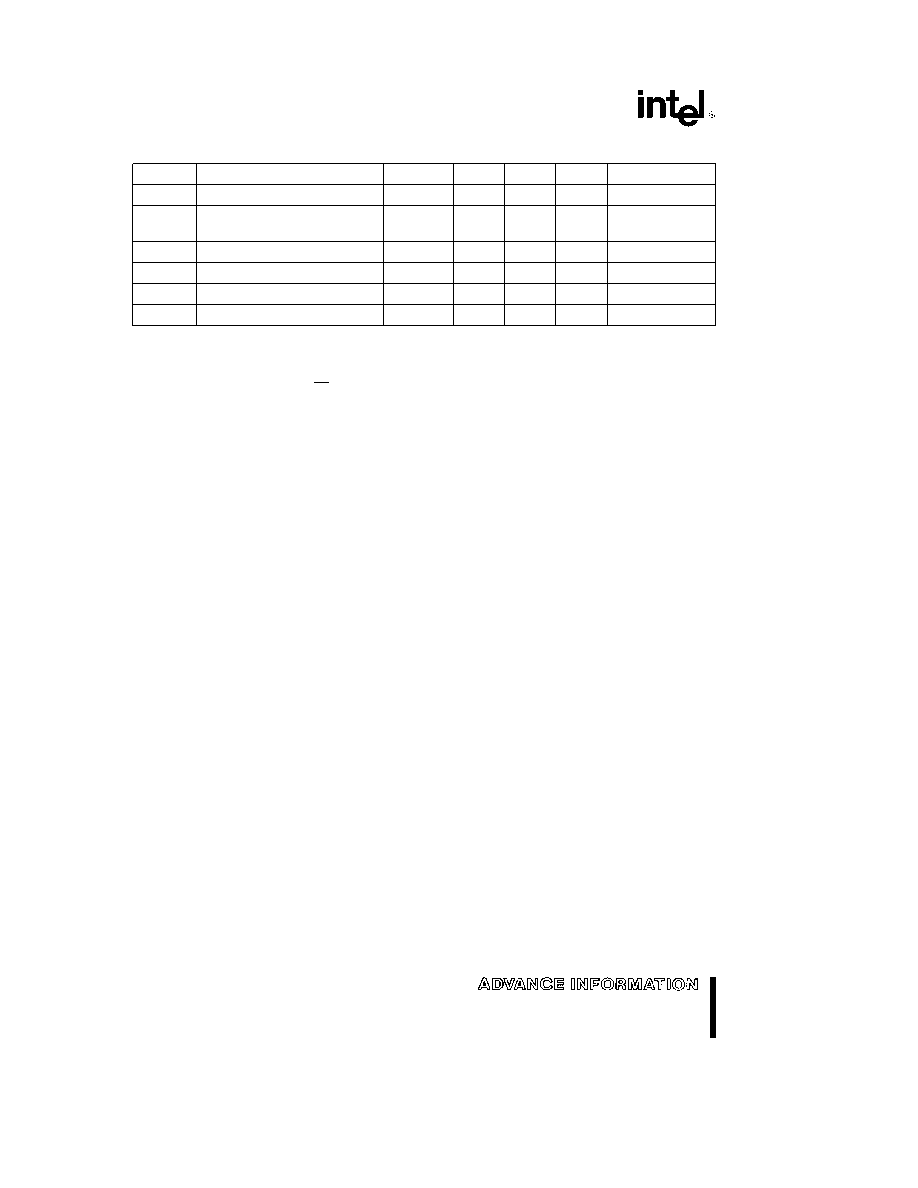
8XC196NT
DC CHARACTERISTICS
(Under Listed Operating Conditions) (Continued)
Symbol
Parameter
Min
Typ
Max
Units
Test Conditions
V
OL1
Output Low Voltage in RESET
0 8
V
(Note 7)
V
OH1
SLPINT (P5 4) and HLDA (P2 6)
2 0
V
I
OH
e
0 8 mA
(7)
Output High Voltage in RESET
V
OH2
Output High Voltage in RESET
V
CC
b
1V
V
I
OH
e b
6 mA
(1)
C
S
Pin Capacitance (Any pin to V
SS
)
10
pF
f
test
e
1 0 MHz
R
WPU
Weak Pullup Resistance
150K
X
(Note 6)
R
RST
Reset Pullup
65K
180K
X
NOTES
1 All BD (bidirectional) pins except INST and CLKOUT INST and CLKOUT are excluded due to their not being weakly
pulled high in reset BD pins include Port1 Port2 Port3 Port4 Port5 Port6 and EPORT except SPLINT (P5 4) and HLDA
(P2 6)
2 Standard input pins include XTAL1 EA RESET and Port 1 2 5 6 and EPORT when setup as inputs
3 All bidirectional I O pins when configured as Outputs (Push Pull)
4 Device is static and should operate below 1 Hz but only tested down to 4 MHz
5 Maximum I
OL
I
OH
currents per pin will be characterized and published at a later date
6 Typicals are based on limited number of samples and are not guaranteed The values listed are at room temperature and
V
REF
e
V
CC
e
5 5V
7 Violating these specifications in reset may cause the device to enter test modes (P5 4 and P2 6)
8 TBD
e
To Be Determined
9 Pullup present during return from powerdown condition
10 When P0 is used as analog inputs refer to A D specifications
11 For temperatures
k
100 C typical is 10 mA
8

8XC196NT
8XC196NT ADDITIONAL BUS TIMING MODES
The 8XC196NT device has 3 additional bus timing
modes for external memory interfacing
MODE 3
Mode 3 is the standard timing mode Use this mode
for systems that emulate the 8XC196KR bus tim-
ings
MODE 0
Mode 0 is the standard timing mode but 1 (mini-
mum) wait state is always inserted in external bus
cycles
MODE 1
Mode 1 is the long R W mode This mode advances
RD and WR signals by 1 T
OSC
creating a 2 T
OSC
RD WR low time ALE is also advanced by 0 5 T
OSC
but ALE high time remains 1 T
OSC
MODE 2
Mode 2 is the long R W mode with Early Address
Mode 2 is similar to Mode 1 with respect to RD WR
and ALE signals Additionally the address is output
on the bus 0 5 T
OSC
earlier in the bus cycle
272267 � 4
Figure 4 Detailed MODE 1 2 3 Comparison
9
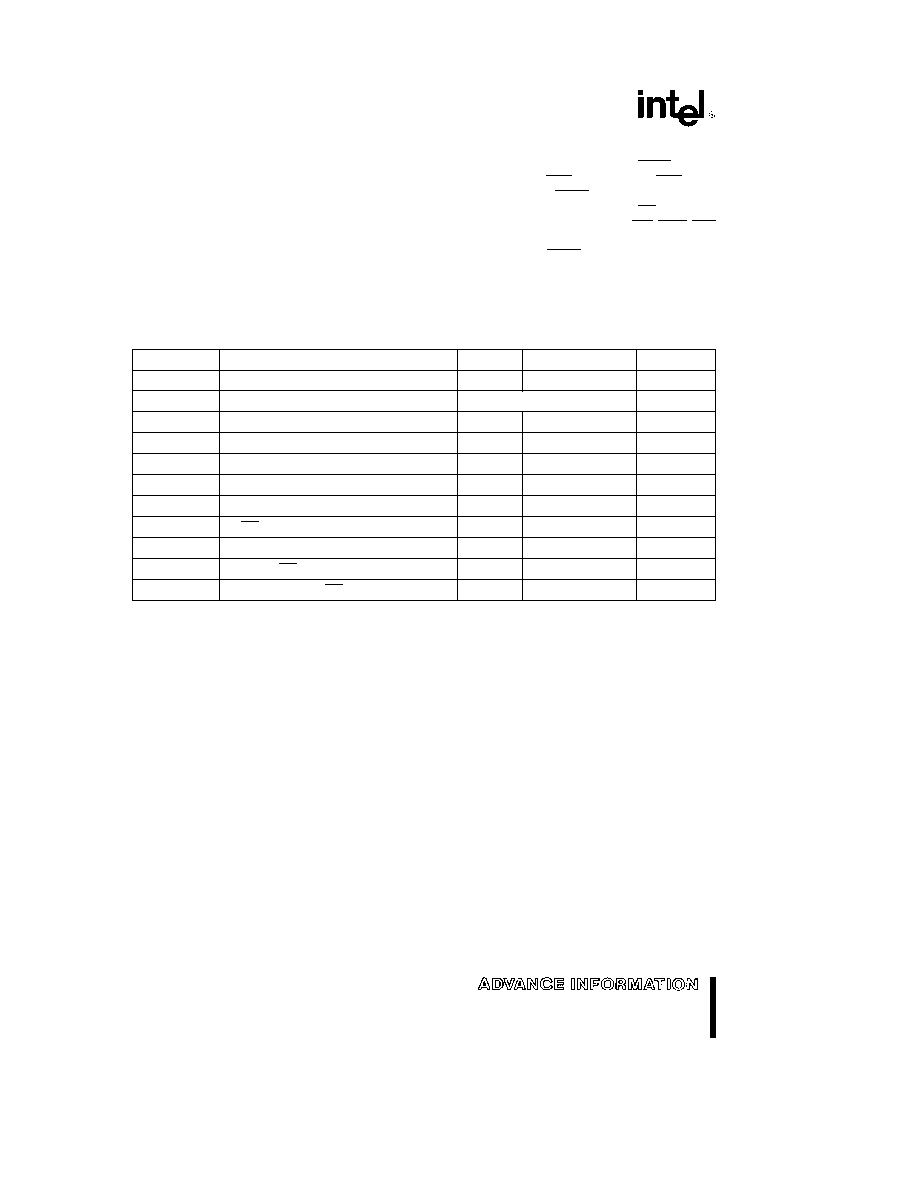
8XC196NT
EXPLANATION OF AC SYMBOLS
Each symbol is two pairs of letters prefixed by ``T''
for time The characters in a pair indicate a signal
and its condition respectively Symbols represent
the time between the two signal condition points
Conditions
Signals
H
High
A
Address
HA
HLDA
L
Low
B
BHE
L
ALE ADV
V
Valid
BR
BREQ
Q
Data Out
X
No Longer
C
CLKOUT
RD
RD
Valid
D
DATA
W
WR WRH WRI
Z
Floating
G
Buswidth
X
XTAL1
H
HOLD
Y
READY
BUS MODE 0 and 3
AC CHARACTERISTICS
(Over Specified Operating Conditions)
Test Conditions Capacitance Load on All Pins e 100 pF Rise and Fall Times e 10 ns
The system must meet these specifications to work with the 8XC196NT
Symbol
Parameter
Min
Max
Units
T
AVYV
Address Valid to Ready Setup
2 T
OSC
b
75
ns
(3)
T
YLYH
Non READY Time
No Upper Limit
ns
T
CLYX
READY Hold after CLKOUT Low
0
T
OSC
b
30
ns
(1)
T
AVGV
Address Valid to BUSWIDTH Setup
2 T
OSC
b
75
ns
(2 3)
T
LLGV
ALE Low to BUSWIDTH Setup
T
OSC
b
60
ns
(2 3)
T
CLGX
BUSWIDTH Hold after CLKOUT Low
0
ns
T
AVDV
Address Valid to Input Data Valid
3 T
OSC
b
55
ns
(2)
T
RLDV
RD active to input Data Valid
T
OSC
b
30
ns
(2)
T
CLDV
CLKOUT Low to Input Data Valid
T
OSC
b
60
ns
T
RHDZ
End of RD to Input Data Float
T
OSC
ns
T
RHDX
Data Hold after RD High
0
ns
NOTES
1 If Max is exceeded additional wait states will occur
2 If wait states are used add 2 T
OSC
c
n where n
e
number of wait states
3 If mode 0 is selected one wait state minimum is always added If additional wait states are required add 2 T
OSC
to the
specification
10
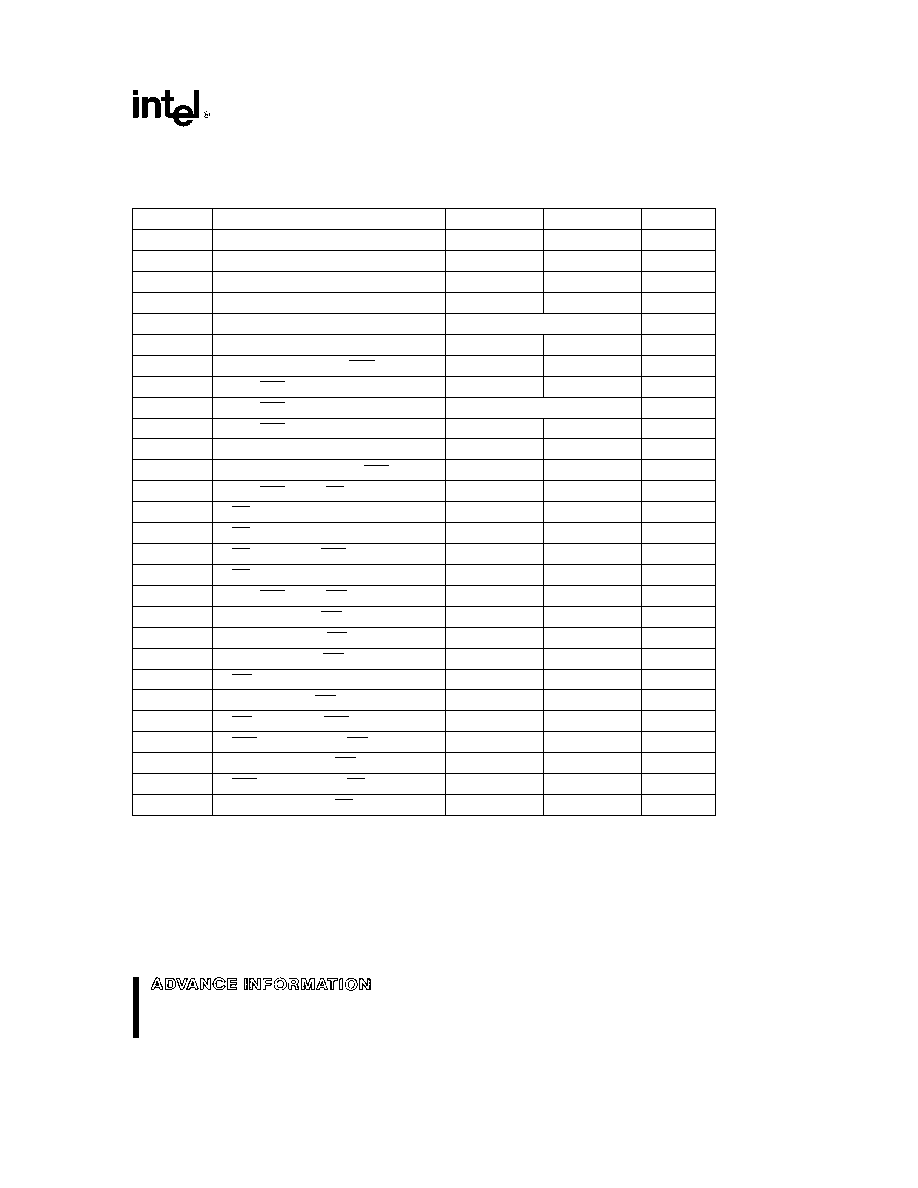
8XC196NT
BUS MODE 0 and 3
AC CHARACTERISTICS
(Over Specified Operating Conditions)
Test Conditions Capacitance Load on All Pins e 100 pF Rise and Fall Times e 10 ns
The 8XC196NT will meet these specifications
Symbol
Parameter
Min
Max
Units
F
XTAL
Frequency on XTAL1
4 0
20
MHz
(1)
T
OSC
XTAL1 Period (1 F
XTAL
)
50
250
ns
T
XHCH
XTAL1 High to CLKOUT High or Low
a
20
110
ns
T
OFD
Clock Failure to Reset Pulled Low
(6)
4
40
m
s
T
CLCL
CLKOUT Period
2 T
OSC
ns
T
CHCL
CLKOUT High Period
T
OSC
b
10
T
OSC
a
30
ns
T
CLLH
CLKOUT Low to ALE ADV High
b
10
a
15
ns
T
LLCH
ALE ADV Low to CLKOUT High
b
25
a
15
ns
T
LHLH
ALE ADV Cycle Time
4 T
OSC
ns
(5)
T
LHLL
ALE ADV High Time
T
OSC
b
10
T
OSC
a
10
ns
T
AVLL
Address Valid to ALE Low
T
OSC
b
15
ns
T
LLAX
Address Hold After ALE ADV Low
T
OSC
b
40
ns
T
LLRL
ALE ADV Low to RD Low
T
OSC
b
40
ns
T
RLCL
RD Low to CLKOUT Low
b
5
a
35
ns
T
RLRH
RD Low Period
T
OSC
b
5
ns
(5)
T
RHLH
RD High to ALE ADV High
T
OSC
T
OSC
a
25
ns
(3)
T
RLAZ
RD Low to Address Float
a
5
ns
T
LLWL
ALE ADV Low to WR Low
T
OSC
b
10
ns
T
CLWL
CLKOUT Low to WR Low
b
10
a
25
ns
T
QVWH
Data Valid before WR High
T
OSC
b
23
ns
T
CHWH
CLKOUT High to WR High
b
10
a
15
ns
T
WLWH
WR Low Period
T
OSC
b
30
ns
(5)
T
WHQX
Data Hold after WR High
T
OSC
b
35
ns
T
WHLH
WR High to ALE ADV High
T
OSC
b
10
T
OSC
a
15
ns
(3)
T
WHBX
BHE INST Hold after WR High
T
OSC
b
10
ns
T
WHAX
AD8 � 15 Hold after WR High
T
OSC
b
30
ns
(4)
T
RHBX
BHE INST Hold after RD High
T
OSC
b
10
ns
T
RHAX
AD8 � 15 Hold after RD High
T
OSC
b
30
ns
(4)
NOTES
1 Testing performed at 8 0 MHz however the device is static by design and will typically operate below 1 Hz
2 Typical specifications not guaranteed
3 Assuming back-to-back bus cycles
4 8-bit bus only
5 If wait states are used add 2 T
OSC
c
n where n
e
number of wait states If mode 0 (1 automatic wait state added)
operation is selected add 2 T
OSC
to specification
6 T
OFD
is the time for the oscillator fail detect circuit (OFD) to react to a clock failure The OFD circuitry is enabled by
programming the UPROM location 0778H with the value 0004H NT NQ customer QROM codes need to equate location
2016H to the value 0CDEH if the oscillator fail detect (OFD) function is desired Intel manufacturing uses location 2016H
as a flag to determine whether or not to program the Clock Detect Enable (CDE) bit Programming the CDE bit
enables oscillator fail detection
11
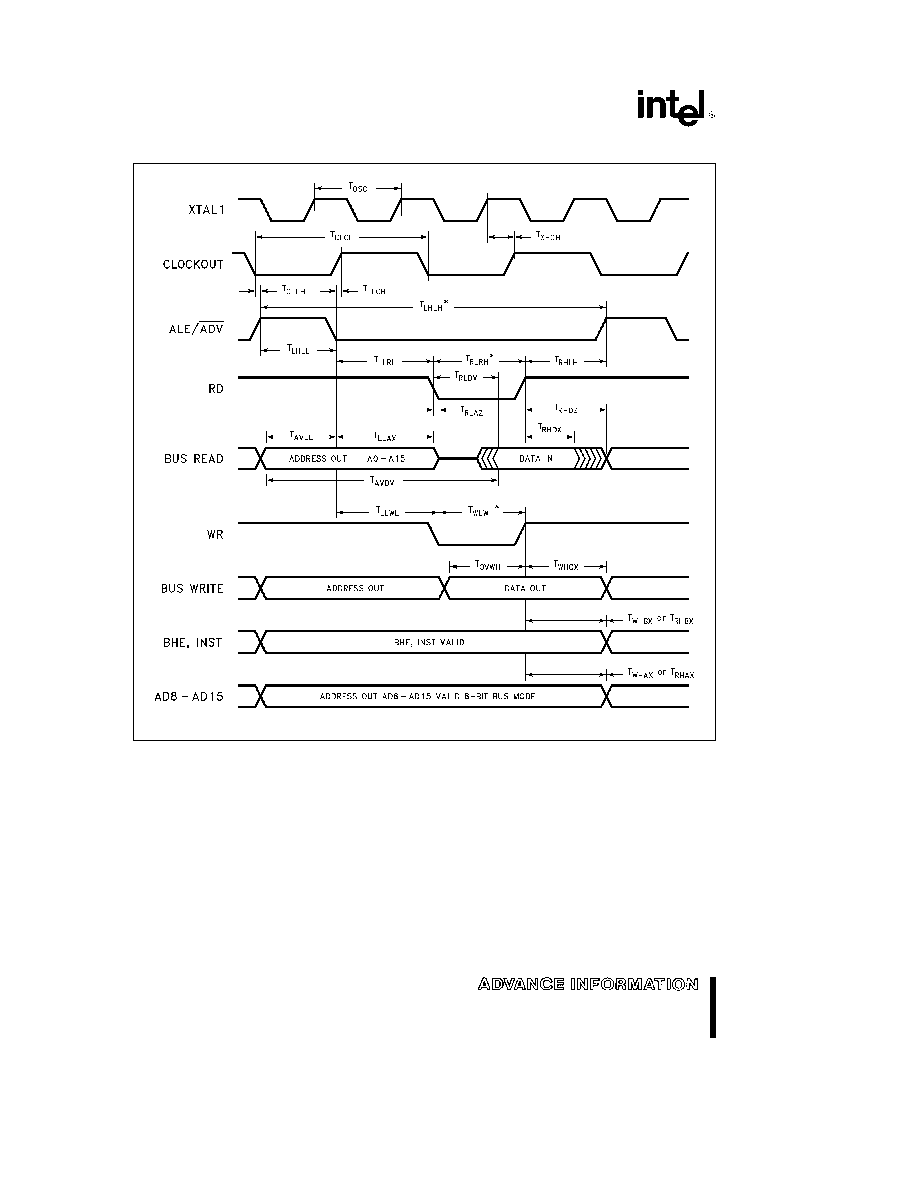
8XC196NT
BUS MODE 0 and 3
8XC196NT SYSTEM BUS TIMING
272267 � 5
If mode 0 operation is selected add 2 T
OSC
to this time
12
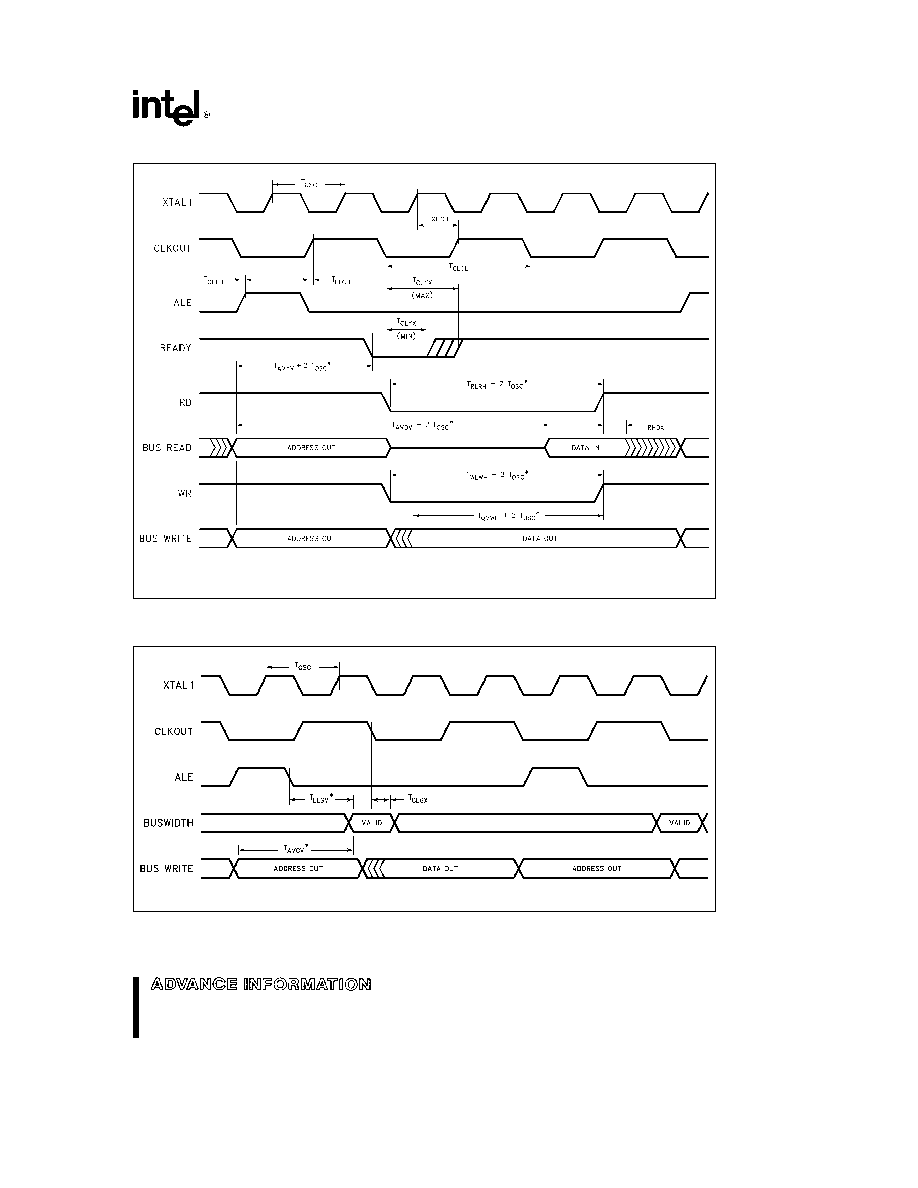
8XC196NT
8XC196NT MODE 0 and 3
READY TIMINGS (ONE WAIT STATE)
272267 � 6
If mode 0 selected one wait state is always added If additional wait states are required add 2 T
OSC
to these specifica-
tions
MODE 0 and 3
8XC196NT BUSWIDTH TIMINGS
272267 � 7
If mode 0 selected add 2 T
OSC
to these specifications
13

8XC196NT
BUS MODE 1
AC CHARACTERISTICS
(Over Specified Operating Conditions)
Test Conditions Capacitance Load on All Pins e 100 pF Rise and Fall Times e 10 ns
The system must meet these specifications to work with the 8XC196NT
Symbol
Parameter
Min
Max
Units
T
AVYV
Address Valid to Ready Setup
2 T
OSC
b
75
ns
T
YLYH
Non READY Time
No Upper Limit
ns
T
CLYX
READY Hold after CLKOUT Low
0
T
OSC
b
30
ns
(1)
T
AVGV
Address Valid to BUSWIDTH Setup
2 T
OSC
b
75
ns
T
LLGV
ALE Low to BUSWIDTH Setup
1 5 T
OSC
b
60
ns
T
CLGX
BUSWIDTH Hold after CLKOUT Low
0
ns
T
AVDV
Address Valid to Input Data Valid
3 T
OSC
b
60
ns
(2)
T
RLDV
RD active to input Data Valid
2 T
OSC
b
44
ns
(2)
T
CLDV
CLKOUT Low to Input Data Valid
T
OSC
b
60
ns
T
RHDZ
End of RD to Input Data Float
T
OSC
ns
T
RHDX
Data Hold after RD High
0
ns
NOTES
1 If Max is exceeded additional wait states will occur
2 If wait states are used add 2 T
OSC
c
n where n
e
number of wait states
14
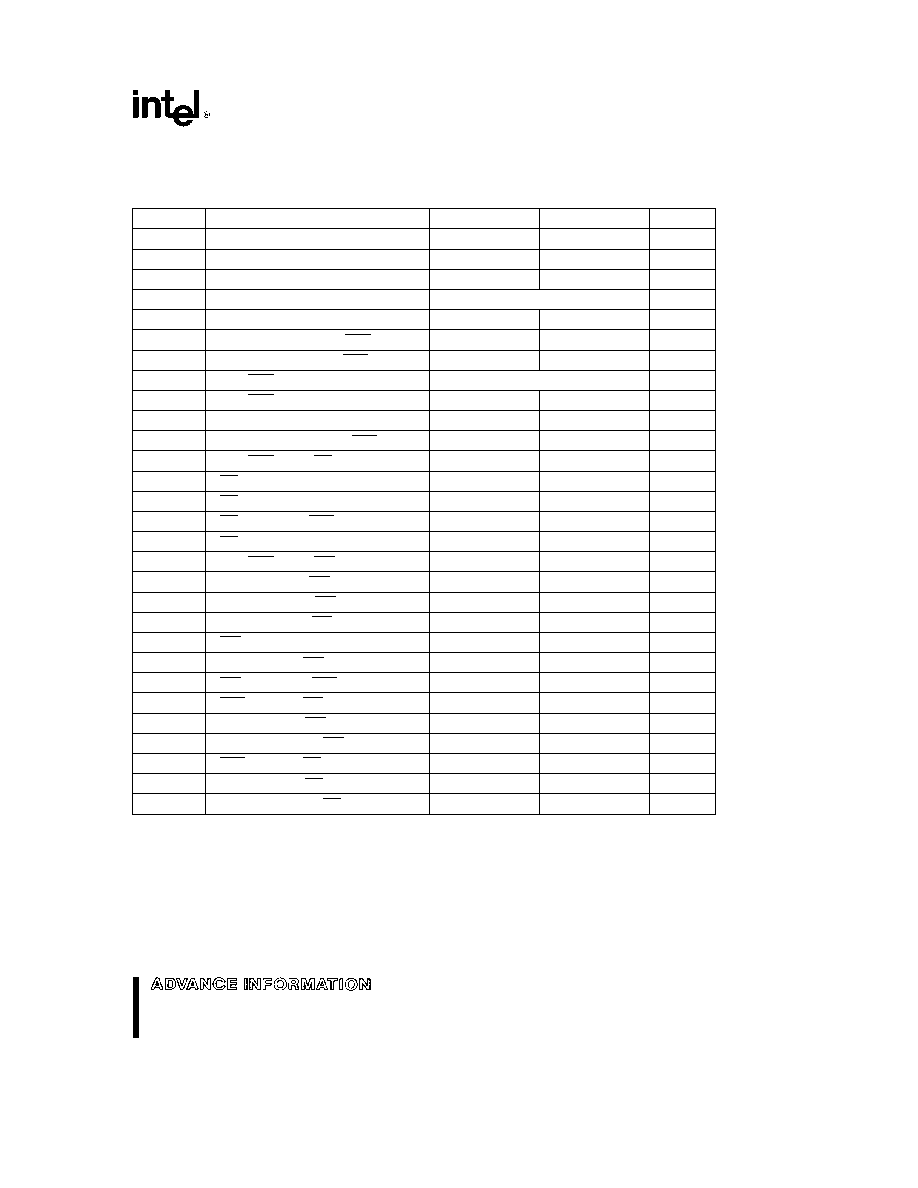
8XC196NT
BUS MODE 1
AC CHARACTERISTICS
(Over Specified Operating Conditions)
Test Conditions Capacitance Load on All Pins e 100 pF Rise and Fall Times e 10 ns
The 8XC196NT will meet these specifications
Symbol
Parameter
Min
Max
Units
F
XTAL
Frequency on XTAL1
8 0
20
MHz
(1)
T
OSC
XTAL1 Period (1 F
XTAL
)
50
125
ns
T
XHCH
XTAL1 High to CLKOUT High or Low
a
20
110
ns
T
CLCL
CLKOUT Period
2 T
OSC
ns
T
CHCL
CLKOUT High Period
T
OSC
b
10
T
OSC
a
27
ns
T
CHLH
CLKOUT HIGH to ALE ADV High
0 5 T
OSC
b
15
0 5 T
OSC
a
15
ns
T
CLLL
CLKOUT LOW to ALE ADV Low
0 5 T
OSC
b
25
0 5 T
OSC
a
15
ns
T
LHLH
ALE ADV Cycle Time
4 T
OSC
ns
(5)
T
LHLL
ALE ADV High Time
T
OSC
b
20
T
OSC
a
10
ns
T
AVLL
Address Valid to ALE Low
0 5 T
OSC
b
20
ns
T
LLAX
Address Hold After ALE ADV Low
0 5 T
OSC
b
25
ns
T
LLRL
ALE ADV Low to RD Low
0 5 T
OSC
b
15
ns
T
RLCL
RD Low to CLKOUT Low
T
OSC
b
10
T
OSC
a
30
ns
T
RLRH
RD Low Period
2 T
OSC
b
20
ns
(5)
T
RHLH
RD High to ALE ADV High
0 5 T
OSC
0 5 T
OSC
a
25
ns
(3)
T
RLAZ
RD Low to Address Float
a
5
ns
T
LLWL
ALE ADV Low to WR Low
0 5 T
OSC
b
10
ns
T
CLWL
CLKOUT Low to WR Low
T
OSC
b
15
T
OSC
a
25
ns
T
QVWH
Data Valid before WR High
2 T
OSC
b
23
ns
T
CHWH
CLKOUT High to WR High
b
10
a
15
ns
T
WLWH
WR Low Period
2 T
OSC
b
15
ns
(5)
T
WHQX
Data Hold after WR High
0 5 T
OSC
b
12
ns
T
WHLH
WR High to ALE ADV High
0 5 T
OSC
b
10
0 5 T
OSC
a
15
ns
(3)
T
WHBX
BHE Hold after WR High
T
OSC
b
15
ns
T
WHIX
INST Hold after WR High
0 5 T
OSC
b
15
T
WHAX
AD8 � 15 Hold after WR High
0 5 T
OSC
b
30
ns
(4)
T
RHBX
BHE Hold after RD High
T
OSC
b
32
ns
T
RHIX
INST Hold after RD High
0 5 T
OSC
b
32
T
RHAX
AD8 � 15 Hold after RD High
0 5 T
OSC
b
30
ns
(4)
NOTES
1 Testing performed at 8 0 MHz however the device is static by design and will typically operate below 1 Hz
2 Typical specifications not guaranteed
3 Assuming back-to-back bus cycles
4 8-bit bus only
5 If wait states are used add 2 T
OSC
c
n where n
e
number of wait states
15
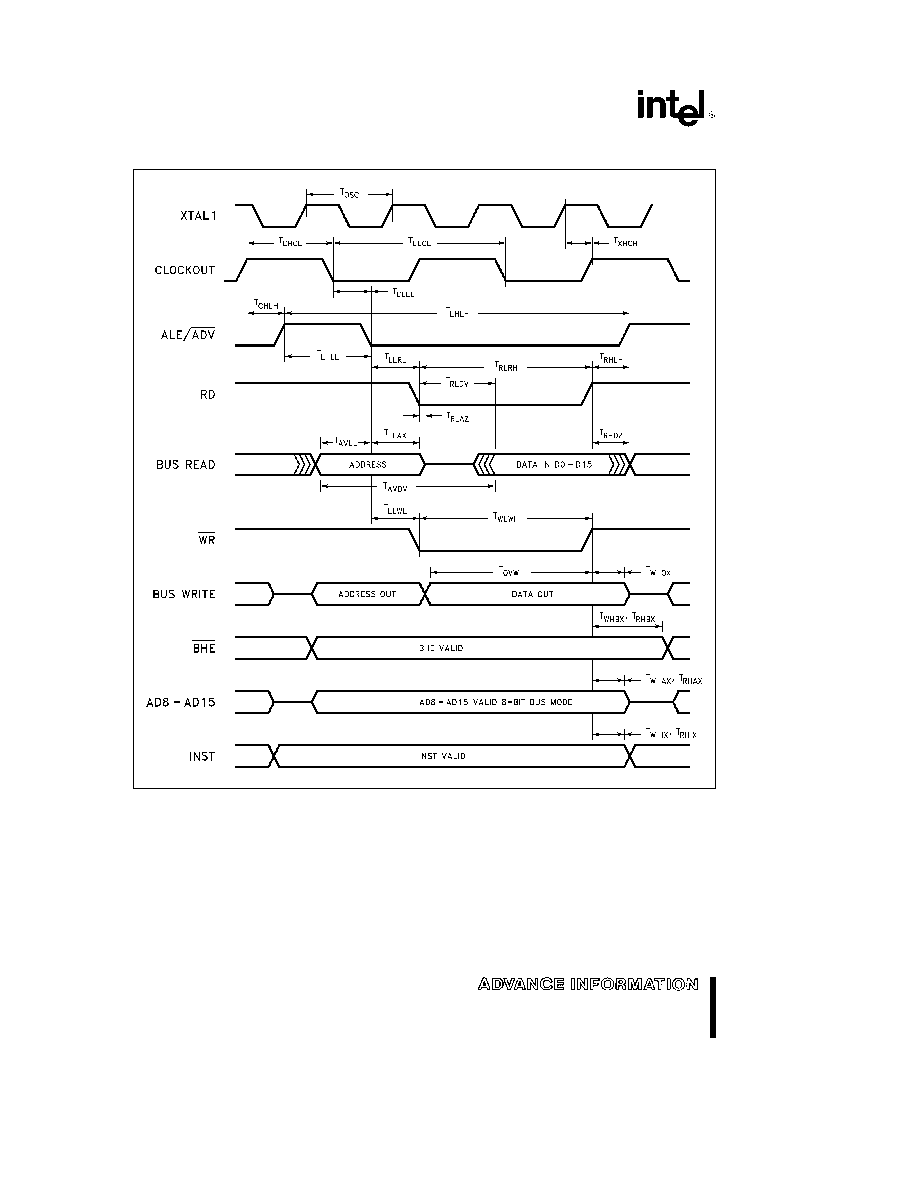
8XC196NT
MODE 1
8XC196NT SYSTEM BUS TIMING
272267 � 8
16

8XC196NT
MODE 1
8XC196NT READY TIMINGS (ONE WAIT STATE)
272267 � 9
MODE 1
8XC196NT BUSWIDTH TIMINGS
272267 � 10
17

8XC196NT
BUS MODE 2
AC CHARACTERISTICS
(Over Specified Operating Conditions)
Test Conditions Capacitance Load on All Pins e 100 pF Rise and Fall Times e 10 ns
The system must meet these specifications to work with the 8XC196NT
Symbol
Parameter
Min
Max
Units
T
AVYV
Address Valid to Ready Setup
2 5 T
OSC
b
75
ns
T
YLYH
Non READY Time
No Upper Limit
ns
T
CLYX
READY Hold after CLKOUT Low
0
T
OSC
b
30
ns
(1)
T
AVGV
Address Valid to BUSWIDTH Setup
2 5 T
OSC
b
75
ns
T
LLGV
ALE Low to BUSWIDTH Setup
1 5 T
OSC
b
60
ns
T
CLGX
BUSWIDTH Hold after CLKOUT Low
0
ns
T
AVDV
Address Valid to Input Data Valid
3 5 T
OSC
b
55
ns
(2)
T
RLDV
RD active to input Data Valid
2 T
OSC
b
44
ns
(2)
T
CLDV
CLKOUT Low to Input Data Valid
T
OSC
b
60
ns
T
RHDZ
End of RD to Input Data Float
0 5 T
OSC
ns
T
RHDX
Data Hold after RD High
0
ns
NOTES
1 If Max is exceeded additional wait states will occur
2 If wait states are used add 2 T
OSC
c
n where n
e
number of wait states
18
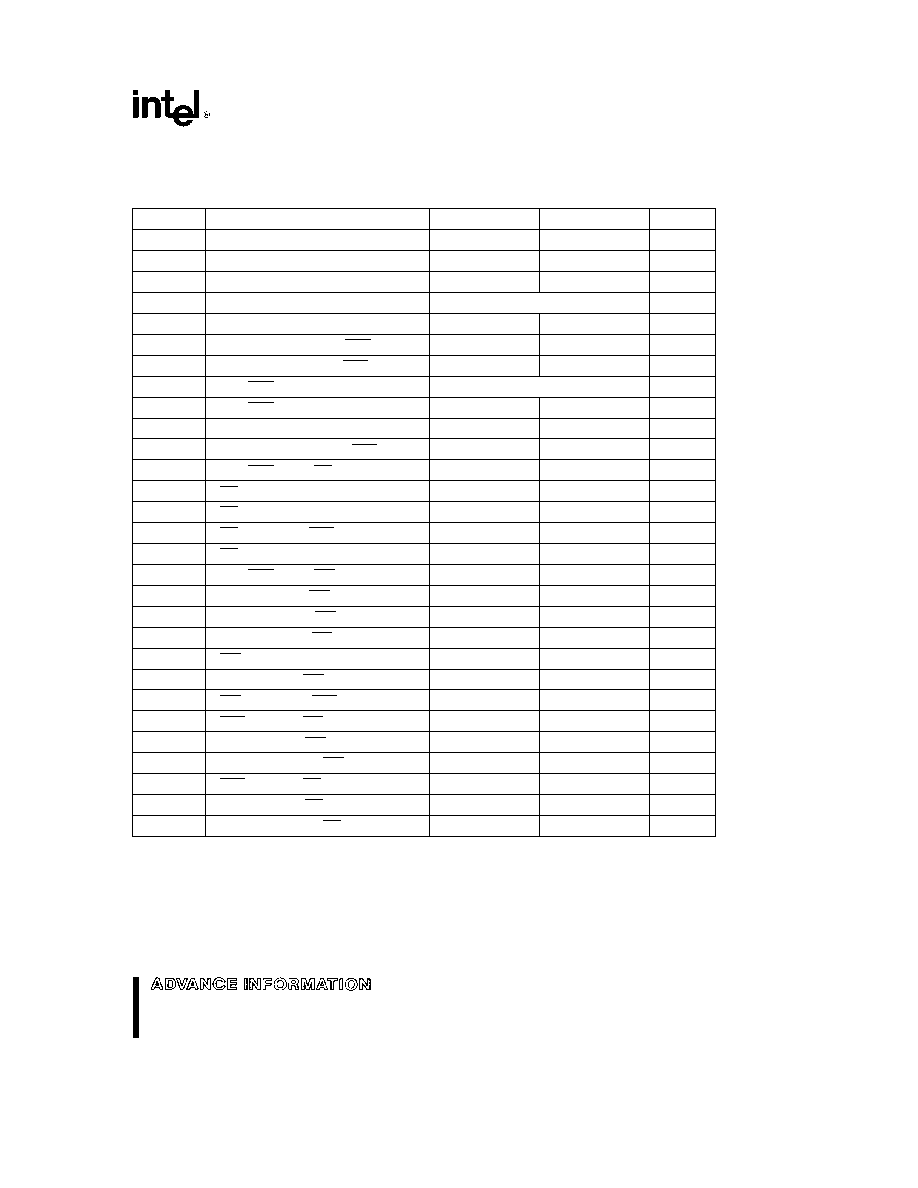
8XC196NT
BUS MODE 2
AC CHARACTERISTICS
(Over Specified Operating Conditions)
Test Conditions Capacitance Load on All Pins e 100 pF Rise and Fall Times e 10 ns
The 8XC196NT will meet these specifications
Symbol
Parameter
Min
Max
Units
F
XTAL
Frequency on XTAL1
8 0
20
MHz
(1)
T
OSC
XTAL1 Period (1 F
XTAL
)
50
125
ns
T
XHCH
XTAL1 High to CLKOUT High or Low
a
20
a
85
ns
T
CLCL
CLKOUT Period
2 T
OSC
ns
T
CHCL
CLKOUT High Period
T
OSC
b
10
T
OSC
a
27
ns
T
CHLH
CLKOUT HIGH to ALE ADV High
0 5 T
OSC
b
15
0 5 T
OSC
a
15
ns
T
CLLL
CLKOUT LOW to ALE ADV Low
0 5 T
OSC
b
25
0 5 T
OSC
a
15
ns
T
LHLH
ALE ADV Cycle Time
4 T
OSC
ns
(5)
T
LHLL
ALE ADV High Time
T
OSC
b
20
T
OSC
a
10
ns
T
AVLL
Address Valid to ALE Low
T
OSC
b
15
ns
T
LLAX
Address Hold After ALE ADV Low
0 5 T
OSC
b
20
ns
T
LLRL
ALE ADV Low to RD Low
0 5 T
OSC
b
15
ns
T
RLCL
RD Low to CLKOUT Low
T
OSC
b
10
T
OSC
a
30
ns
T
RLRH
RD Low Period
2 T
OSC
b
20
ns
(5)
T
RHLH
RD High to ALE ADV High
0 5 T
OSC
b
5
0 5 T
OSC
a
25
ns
(3)
T
RLAZ
RD Low to Address Float
a
5
ns
T
LLWL
ALE ADV Low to WR Low
0 5 T
OSC
b
10
ns
T
CLWL
CLKOUT Low to WR Low
T
OSC
b
22
T
OSC
a
25
ns
T
QVWH
Data Valid before WR High
2 T
OSC
b
25
ns
T
CHWH
CLKOUT High to WR High
b
10
a
15
ns
T
WLWH
WR Low Period
2 T
OSC
b
20
ns
(5)
T
WHQX
Data Hold after WR High
0 5 T
OSC
b
12
ns
T
WHLH
WR High to ALE ADV High
0 5 T
OSC
b
10
0 5 T
OSC
a
10
ns
(3)
T
WHBX
BHE Hold after WR High
T
OSC
b
15
ns
T
WHIX
INST Hold after WR High
0 5 T
OSC
b
15
T
WHAX
AD8 � 15 Hold after WR High
0 5 T
OSC
b
30
ns
(4)
T
RHBX
BHE Hold after RD High
T
OSC
b
32
ns
T
RHIX
INST Hold after RD High
0 5 T
OSC
b
32
T
RHAX
AD8 � 15 Hold after RD High
0 5 T
OSC
b
30
ns
(4)
NOTES
1 Testing performed at 8 0 MHz however the device is static by design and will typically operate below 1 Hz
2 Typical specifications not guaranteed
3 Assuming back-to-back bus cycles
4 8-bit bus only
5 If wait states are used add 2 T
OSC
c
n where n
e
number of wait states
19

8XC196NT
MODE 2
8XC196NT SYSTEM BUS TIMING
272267 � 11
20

8XC196NT
MODE 2
8XC196NT READY TIMINGS (ONE WAIT STATE)
272267 � 12
MODE 2
8XC196NT BUSWIDTH TIMINGS
272267 � 13
21
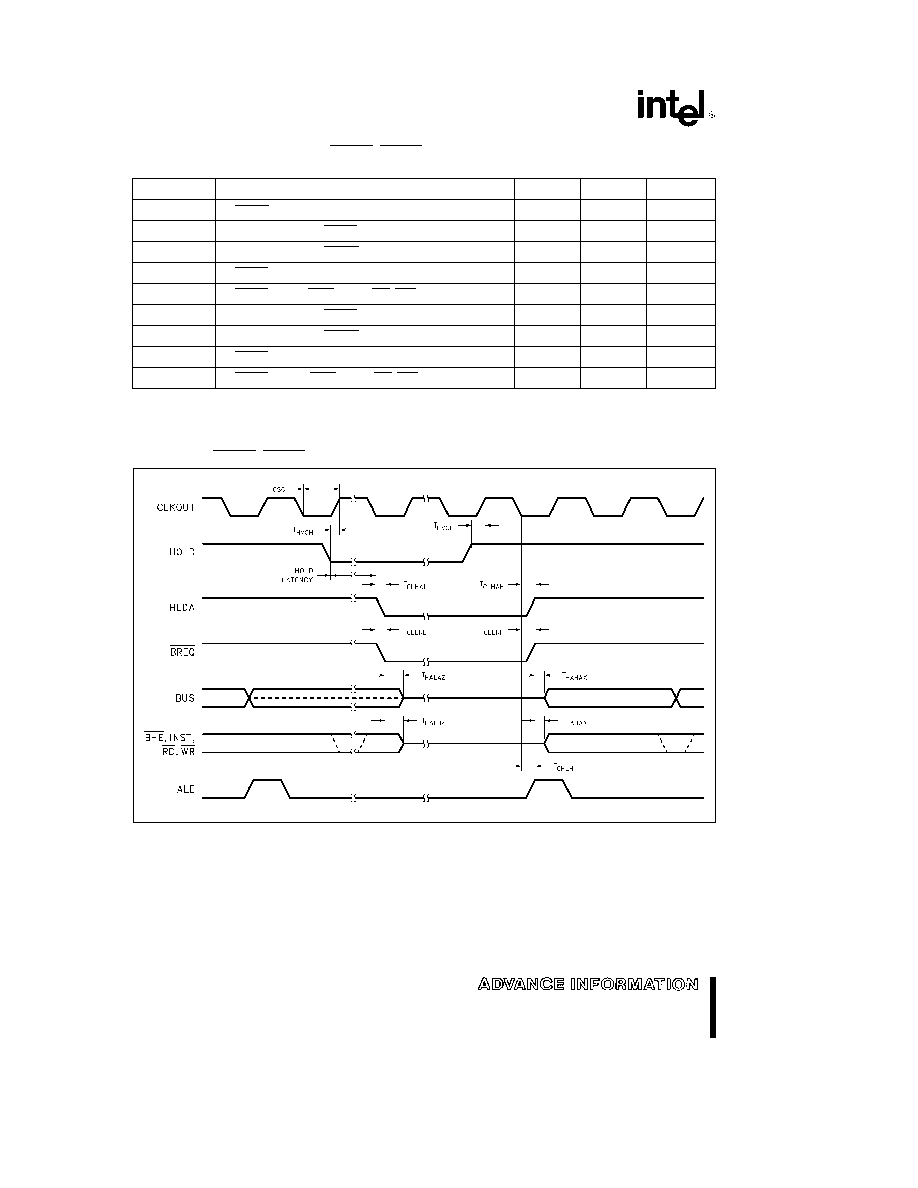
8XC196NT
BUS MODE 0 1 2 and 3
HOLD HLDA TIMINGS
(Over Specified Operation Conditions)
Test Conditions Capacitance Load on All Pins e 100 pF Rise and Fall Times e 10 ns
Symbol
Parameter
Min
Max
Units
T
HVCH
HOLD Setup Time
a
65
ns
(1)
T
CLHAL
CLKOUT Low to HLDA Low
b
15
a
15
ns
T
CLBRL
CLKOUT Low to BREQ Low
b
15
a
15
ns
T
HALAZ
HLDA Low to Address Float
a
25
ns
T
HALBZ
HLDA Low to BHE INST RD WR Weakly Driven
a
25
ns
T
CLHAH
CLKOUT Low to HLDA High
b
25
a
15
ns
T
CLBRH
CLKOUT Low to BREQ High
b
25
a
25
ns
T
HAHAX
HLDA High to Address No Longer Float
b
15
ns
T
HAHBV
HLDA High to BHE INST RD WR Valid
b
10
ns
NOTE
1 To guarantee recognition at next clock
8XC196NT HOLD HLDA TIMINGS
272267 � 14
22

8XC196NT
AC CHARACTERISTICS
SLAVE PORT
SLAVE PORT WAVEFORM
(SLPL e 0)
272267 � 15
SLAVE PORT TIMING
(SLPL e 0)
Symbol
Parameter
Min
Max
Units
T
SAVWL
Address Valid to WR Low
50
ns
T
SRHAV
RD High to Address Valid
60
ns
T
SRLRH
RD Low Period
T
OSC
ns
T
SWLWH
WR Low Period
T
OSC
ns
T
SRLDV
RD Low to Output Data Valid
60
ns
T
SDVWH
Input Data Setup to WR High
20
ns
T
SWHQX
WR High to Data Invalid
30
ns
T
SRHDZ
RD High to Data Float
15
ns
NOTES
1 Test Conditions F
OSC
e
20 MHz T
OSC
e
50 ns Rise Fall Time
e
10 ns Capacitive Pin Load
e
100 pF
2 These values are not tested in production and are based upon theoretical estimates and or laboratory tests
3 Specifications above are advanced information and are subject to change
23
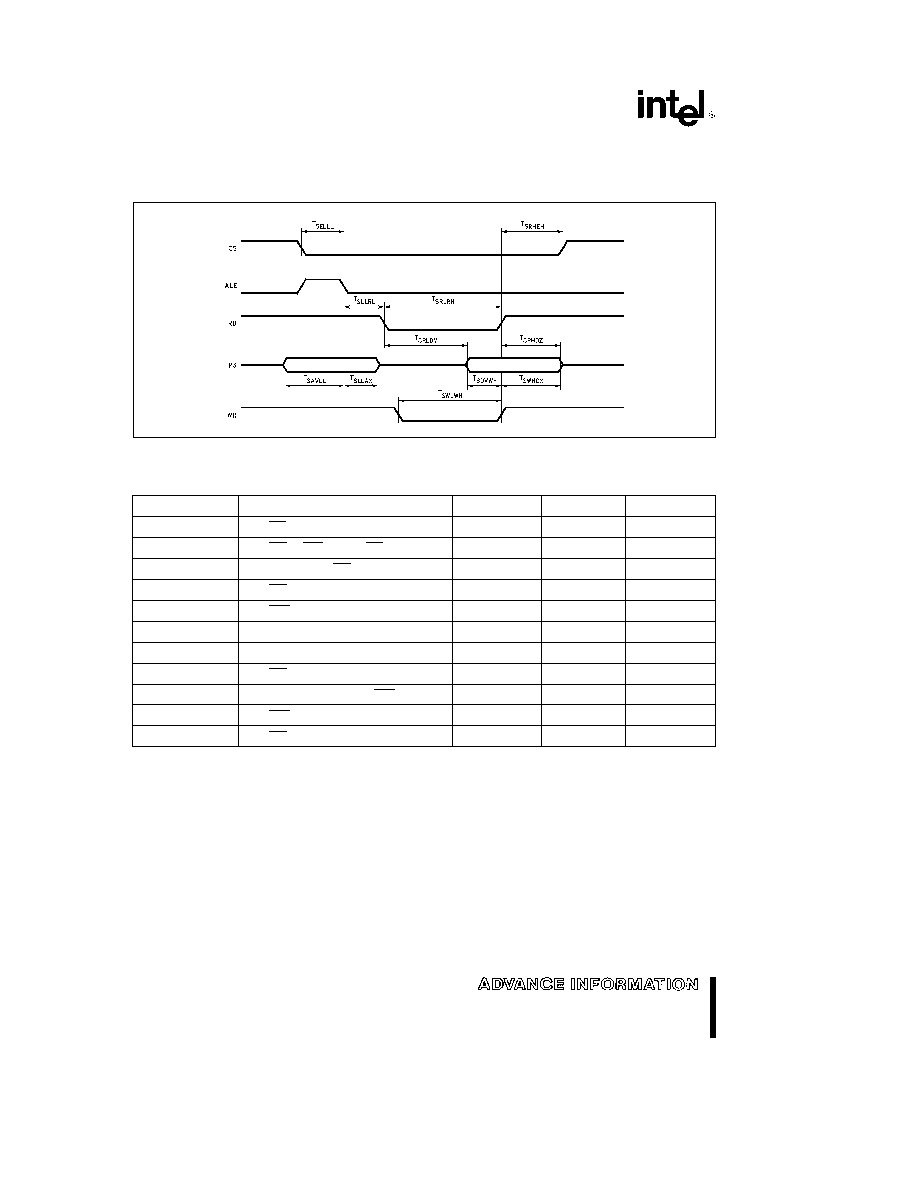
8XC196NT
AC CHARACTERISTICS
SLAVE PORT
(Continued)
SLAVE PORT WAVEFORM
(SLPL e 1)
272267 � 16
SLAVE PORT TIMING
(SLPL e 1)
Symbol
Parameter
Min
Max
Units
T
SELLL
CS Low to ALE Low
20
ns
T
SRHEH
RD or WR High to CS High
60
ns
T
SLLRL
ALE Low to RD Low
T
OSC
ns
T
SRLRH
RD Low Period
T
OSC
ns
T
SWLWH
WR Low Period
T
OSC
ns
T
SAVLL
Address Valid to ALE Low
20
ns
T
SLLAX
ALE Low to Address Invalid
20
ns
T
SRLDV
RD Low to Output Data Valid
60
ns
T
SDVWH
Input Data Setup to WR High
20
ns
T
SWHQX
WR High to Data Invalid
30
ns
T
SRHDZ
RD High to Data Float
15
ns
NOTES
1 Test Conditions F
OSC
e
20 MHz T
OSC
e
50 ns Rise Fall Time
e
10 ns Capacitive Pin Load
e
100 pF
2 These values are not tested in production and are based upon theoretical estimates and or laboratory tests
3 Specifications above are advanced information and are subject to change
24
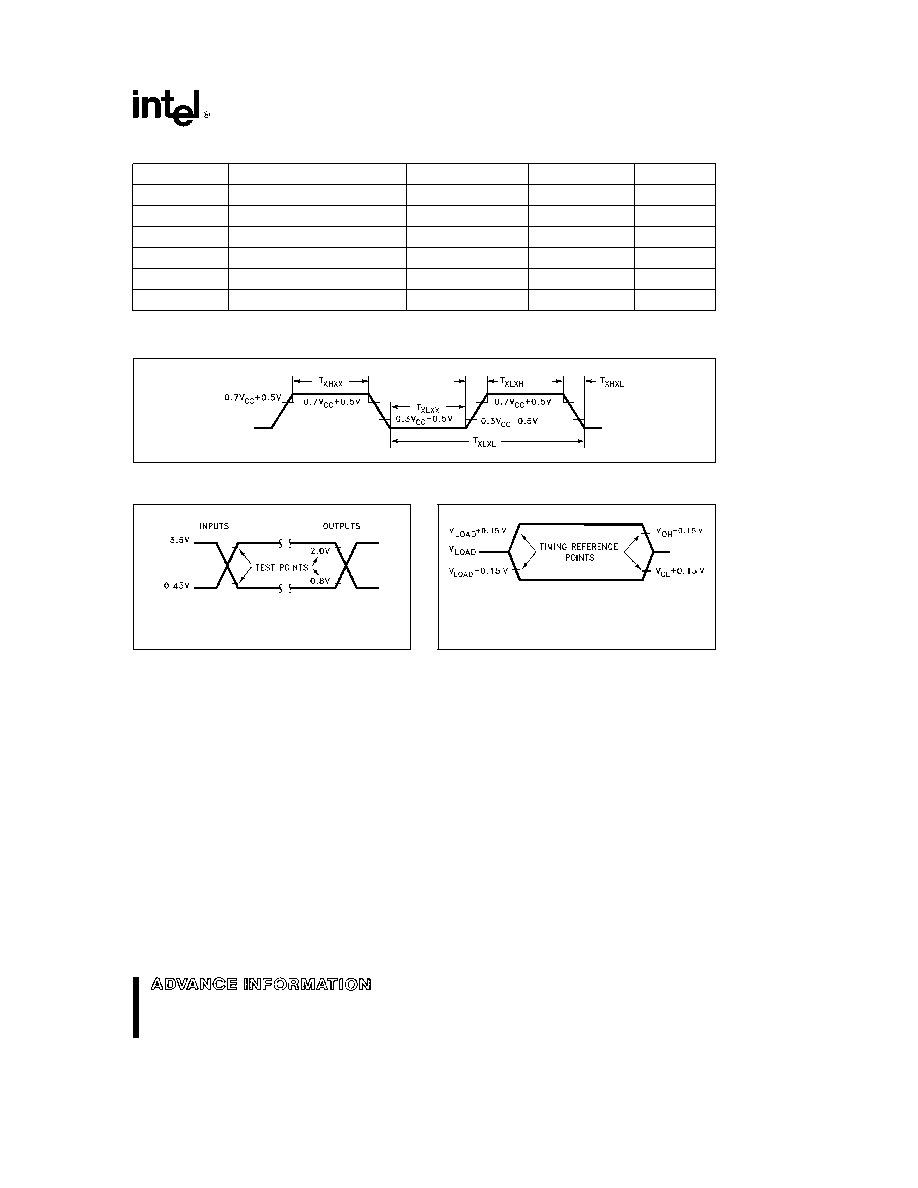
8XC196NT
EXTERNAL CLOCK DRIVE
Symbol
Parameter
Min
Max
Units
1 T
XLXL
Oscillator Frequency
4
20
MHz
T
XLXL
Oscillator Period (T
OSC
)
50
250
ns
T
XHXX
High Time
0 35
c
T
OSC
0 65 T
OSC
ns
T
XLXX
Low Time
0 35
c
T
OSC
0 65 T
OSC
ns
T
XLXH
Rise Time
10
ns
T
XHXL
Fall Time
10
ns
EXTERNAL CLOCK DRIVE WAVEFORMS
272267 � 17
AC TESTING INPUT OUTPUT WAVEFORMS
272267 � 18
AC Testing inputs are driven at 3 5V for a logic ``1'' and
0 45V for a logic ``0'' Timing measurements are made
at 2 0V for a logic ``1'' and 0 8V for logic ``0''
FLOAT WAVEFORMS
272267 � 19
For timing purposes a Port Pin is no longer floating
when a 150 mV change from load voltage occurs and
begins to float when a 150 mV change from the loading
V
OH
V
OL
level occurs I
OL
I
OH
s
15 mA
25

8XC196NT
WAVEFORM
SERIAL PORT
SHIFT REGISTER MODE
SERIAL PORT WAVEFORM
SHIFT REGISTER MODE (MODE 0)
272267 � 20
AC CHARACTERISTICS
SERIAL PORT-SHIFT REGISTER MODE
SERIAL PORT TIMING
SHIFT REGISTER MODE (MODE 0)
Test Conditions T
A
e b
40 C to a125 C V
CC
e
5 0V
g
10% V
SS
e
0 0V Load Capacitance e pF
Symbol
Parameter
Min
Max
Units
T
XLXL
(2)
Serial Port Clock Period (BRR
t
8002H) Receive Only
6 T
OSC
ns
T
XLXH
(2)
Serial Port Clock Falling Edge to Rising Edge (BRR
t
8002H)
4 T
OSC
b
50 4 T
OSC
a
50
ns
T
XLXL
(2)
Serial Port Clock Period (BRR e 8001H) Transmit Only
4 T
OSC
ns
T
XLXH
(2)
Serial Port Clock Falling Edge to Rising Edge (BRR e 8001H) 2 T
OSC
b
50 2 T
OSC
a
50
ns
T
QVXH
Output Data Setup to Clock Rising Edge
3 T
OSC
ns
T
XHQX
Output Data Hold after Clock Rising Edge
2 T
OSC
b
50
ns
T
XHQV
Next Output Data Valid after Clock Rising Edge
2 T
OSC
a
50
ns
T
DVXH
Input Data Setup to Clock Rising Edge
2 T
OSC
a
200
ns
T
XHDX
(1)
Input Data Hold after Clock Rising Edge
0
ns
T
XHQZ
(1)
Last Clock Rising to Output Float
5 T
OSC
ns
NOTES
1 Parameters not tested
2 The minimum baud rate register value for Receive is 8002H The minimum baud rate register value for Transmit is 8001H
26

8XC196NT
A to D CHARACTERISTICS
The A D converter is ratiometric so absolute accuracy is dependent on the accuracy and stability of V
REF
10-BIT MODE A D OPERATING CONDITIONS
Symbol
Description
Min
Max
Units
T
A
Ambient Temperature
0
a
70
C
V
CC
Digital Supply Voltage
4 50
5 50
V
V
REF
Analog Supply Voltage
4 50
5 50
V
(1)
T
SAM
Sample Time
1 0
m
s
(2)
T
CONV
Conversion Time
10
15
m
s
(2)
F
OSC
Oscillator Frequency
4 0
20
MHz
NOTES
1 V
REF
must be within 0 5V of V
CC
2 The value of AD
TIME is selected to meet these specifications
10-BIT MODE A D CHARACTERISTICS
(Using Above Operating Conditions)
(6)
Parameter
Typ
(1)
Min
Max
Units
Resolution
1024
1024
Level
10
10
Bits
Absolute Error
0
g
3 0
LSBs
Full Scale Error
0 25
g
0 5
LSBs
Zero Offset Error
0 25
g
0 5
LSBs
Non-Linearity
1 0
g
2 0
g
3 0
LSBs
Differential Non-Linearity
b
0 75
a
0 75
LSBs
Channel-to-Channel Matching
g
0 1
0
g
1 0
LSBs
Repeatability
g
0 25
0
LSBs
(1)
Temperature Coefficients
Offset
0 009
LSB C
(1)
Full Scale
0 009
LSB C
(1)
Differential Non-Linearity
0 009
LSB C
(1)
Off Isolation
b
60
dB
(1 2 3)
Feedthrough
b
60
dB
(1 2)
V
CC
Power Supply Rejection
b
60
dB
(1 2)
Input Resistance
750
1 2K
X
(4)
DC Input Leakage
g
1 0
0
g
3 0
m
A
Voltage on Analog Input Pin
ANGND b 0 5
V
REF
a
0 5
V
(5)
Sampling Capacitor
3 0
pF
An ``LSB'' as used here has a value of approximately 5 mV
NOTES
1 These values are expected for most parts at 25 C but are not tested or guaranteed
2 DC to 100 KHz
3 Multiplexer break-before-make is guaranteed
4 Resistance from device pin through internal MUX to sample capacitor
5 Applying voltages beyond these specifications will degrade the accuracy of other channels being converted
6 All conversions performed with processor in IDLE mode
27

8XC196NT
8-BIT MODE A D OPERATING CONDITIONS
Symbol
Description
Min
Max
Units
T
A
Ambient Temperature
0
a
70
C
V
CC
Digital Supply Voltage
4 50
5 50
V
V
REF
Analog Supply Voltage
4 50
5 50
V
(1)
T
SAM
Sample Time
1 0
m
s
(2)
T
CONV
Conversion Time
7
20
m
s
(2)
F
OSC
Oscillator Frequency
4 0
20
MHz
NOTES
1 V
REF
must be within 0 5V of V
CC
2 The value of AD
TIME is selected to meet these specifications
8-BIT MODE A D CHARACTERISTICS
(Using Above Operating Conditions)
(6)
Parameter
Typ
(1)
Min
Max
Units
Resolution
256
256
Level
8
8
Bits
Absolute Error
0
g
1 0
LSBs
Full Scale Error
g
0 5
LSBs
Zero Offset Error
g
0 5
LSBs
Non-Linearity
0
g
1 0
LSBs
Differential Non-Linearity
b
0 5
a
0 5
LSBs
Channel-to-Channel Matching
0
g
1 0
LSBs
Repeatability
g
0 25
0
LSBs
(1)
Temperature Coefficients
Offset
0 003
LSB C
(1)
Full Scale
0 003
LSB C
(1)
Differential Non-Linearity
0 003
LSB C
(1)
Off Isolation
b
60
dB
(1 2 3)
Feedthrough
b
60
dB
(1 2)
V
CC
Power Supply Rejection
b
60
dB
(1 2)
Input Resistance
750
1 2K
X
(4)
DC Input Leakage
g
1 0
0
g
3 0
m
A
Voltage on Analog Input Pin
ANGND b 0 5
V
REF
a
0 5
V
(5)
Sampling Capacitor
3 0
pF
An ``LSB'' as used here has a value of approximately 5 mV
NOTES
1 These values are expected for most parts at 25 C but are not tested or guaranteed
2 DC to 100 KHz
3 Multiplexer break-before-make is guaranteed
4 Resistance from device pin through internal MUX to sample capacitor
5 Applying voltage beyond these specifications will degrade the accuracy of other channels being converted
6 All conversions performed with processor in IDLE mode
28
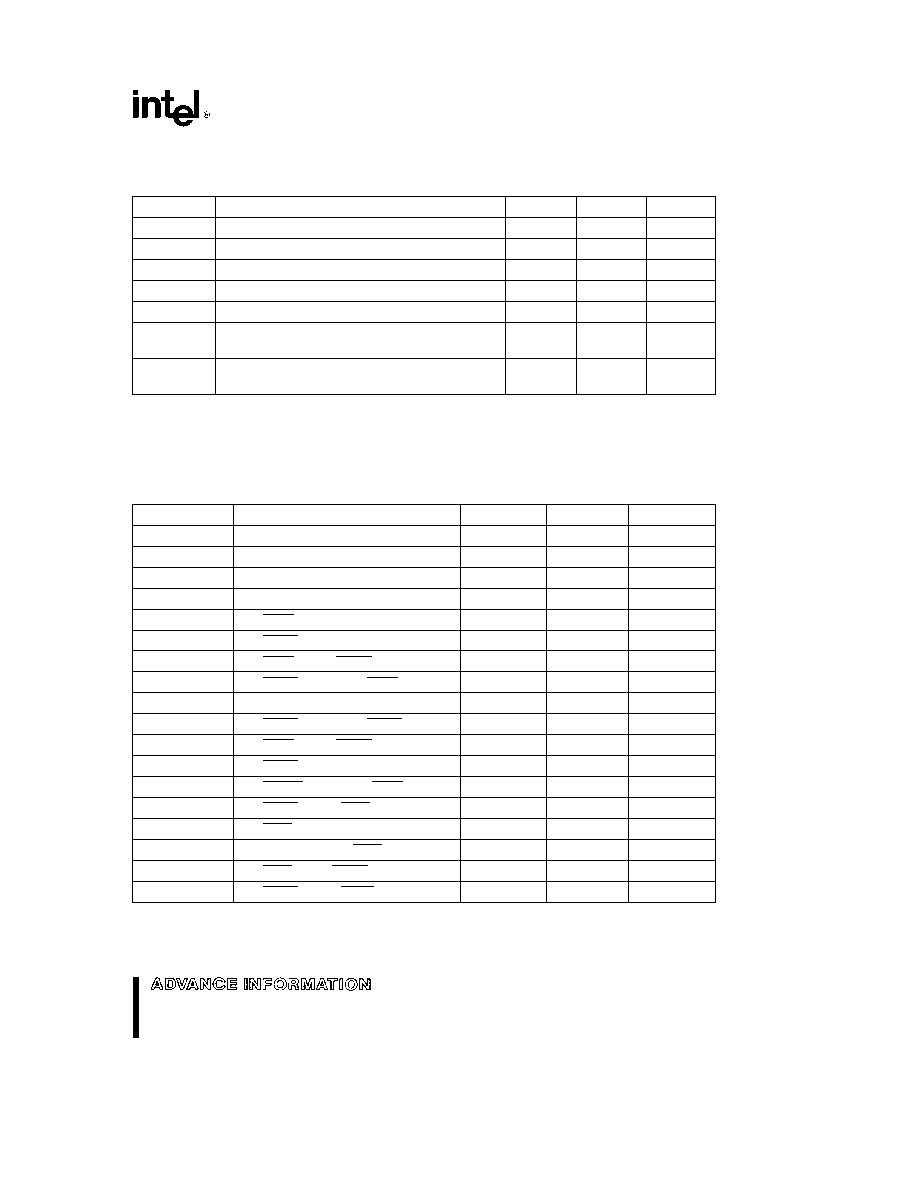
8XC196NT
OTPROM SPECIFICATIONS
OPERATING CONDITIONS
Symbol
Description
Min
Max
Units
T
A
Ambient Temperature During Programming
20
30
C
V
CC
Supply Voltage During Programming
4 5
5 5
V
(1)
V
REF
Reference Supply Voltage During Programming
4 5
5 5
V
(1)
V
PP
Programming Voltage
12 25
12 75
V
(2)
V
EA
EA Pin Voltage
12 25
12 75
V
(2)
F
OSC
Oscillator Frequency during Auto
6 0
8 0
MHz
and Slave Mode Programming
F
OSC
Oscillator Frequency during
6 0
20 0
MHz
Run-Time Programming
NOTES
1 V
CC
and V
REF
should nominally be at the same voltage during programming
2 V
PP
and V
EA
must never exceed the maximum specification or the device may be damaged
3 V
SS
and ANGND should nominally be at the same potential (0V)
4 Load capacitance during Auto and Slave Mode programming
e
150 pF
AC OTPROM PROGRAMMING CHARACTERISTICS (SLAVE MODE)
Symbol
Parameter
Min
Max
Units
T
AVLL
Address Setup Time
0
T
OSC
T
LLAX
Address Hold Time
100
T
OSC
T
DVPL
Data Setup Time
0
T
OSC
T
PLDX
Data Hold Time
400
T
OSC
T
LLLH
PALE Pulse Width
50
T
OSC
T
PLPH
PROG Pulse Width
(2)
50
T
OSC
T
LHPL
PALE High to PROG Low
220
T
OSC
T
PHLL
PROG High to next PALE Low
220
T
OSC
T
PHDX
Word Dump Hold Time
50
T
OSC
T
PHPL
PROG High to next PROG Low
220
T
OSC
T
LHPL
PALE High to PROG Low
220
T
OSC
T
PLDV
PROG Low to Word Dump Valid
50
T
OSC
T
SHLL
RESET High to First PALE Low
1100
T
OSC
T
PHIL
PROG High to AINC Low
0
T
OSC
T
ILIH
AINC Pulse Width
240
T
OSC
T
ILVH
PVER Hold after AINC Low
50
T
OSC
T
ILPL
AINC Low to PROG Low
170
T
OSC
T
PHVL
PROG High to PVER Valid
220
T
OSC
NOTES
1 Run-time programming is done with F
OSC
e
6 0 MHz to 10 0 MHz V
CC
V
PD
V
REF
e
5V
g
0 5V T
C
e
25 C
g
5 C and
V
PP
e
12 5V
g
0 25V For run-time programming over a full operating range contact factory
2 This specification is for the word dump mode For programming pulses use Modified Quick Pulse Algorithm
29
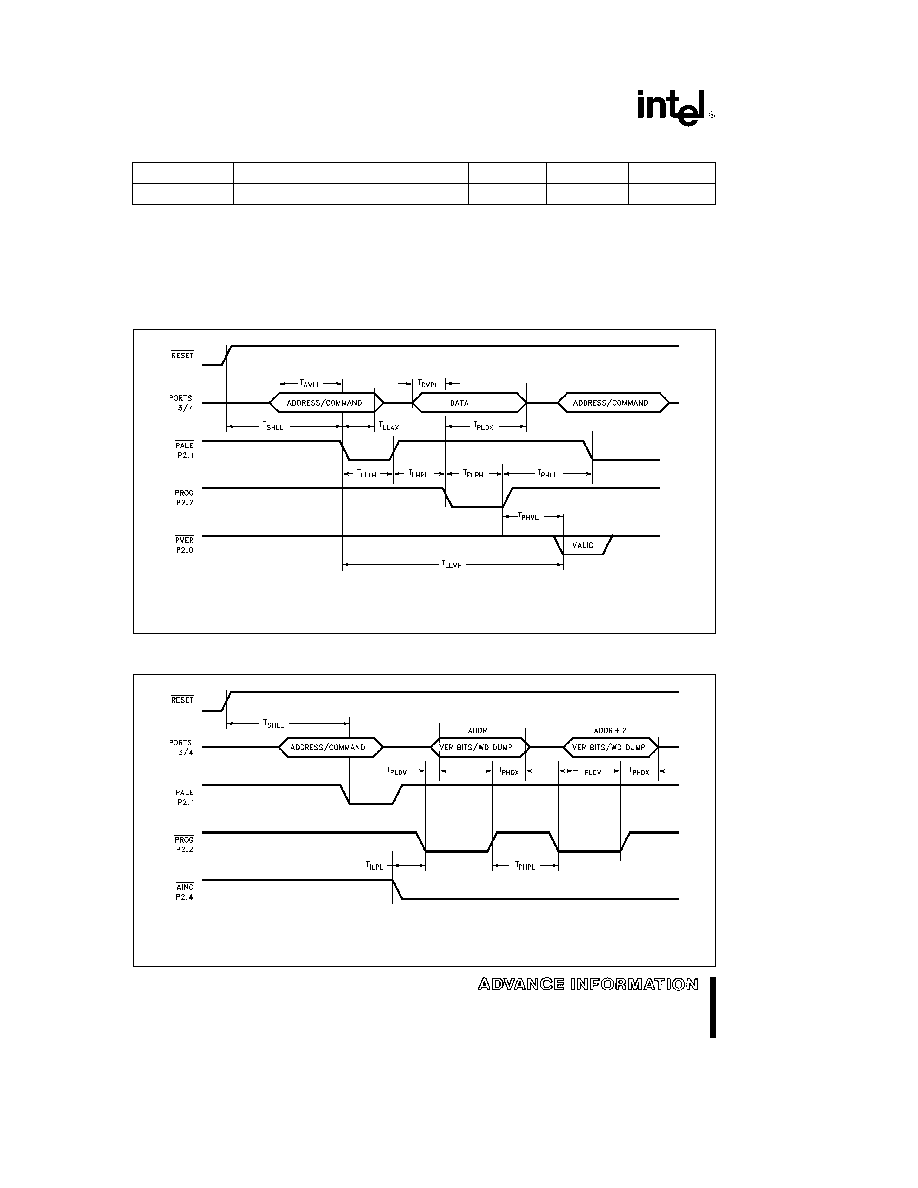
8XC196NT
DC OTPROM PROGRAMMING CHARACTERISTICS
Symbol
Parameter
Min
Max
Units
I
PP
V
PP
Programming Supply Current
200
mA
NOTE
Do not apply V
PP
unti V
CC
is stable and within specifications and the oscillator clock has stabilized or the device may be
damaged
OTPROM PROGRAMMING WAVEFORMS
SLAVE PROGRAMMING MODE DATA PROGRAM MODE WITH SINGLE PROGRAM PULSE
272267 � 21
NOTE
P3 0 must be high (``1'')
SLAVE PROGRAMMING MODE IN WORD DUMP MODE WITH AUTO INCREMENT
272267 � 22
NOTE
P3 0 must be low (``0'')
30

8XC196NT
SLAVE PROGRAMMING MODE TIMING IN DATA PROGRAM MODE WITH REPEATED PROG PULSE
AND AUTO INCREMENT
272267 � 23
This data sheet (272267-004) applies to devices
marked with a ``D'' at the end of the top side tracking
number
8XC196NT Design Considerations
1 When operating in bus timing modes 1 or 2 the
upper and lower address data lines must be
latched Even in 8-bit bus mode the upper ad-
dress lines must be latched In modes 0 and 3
the upper address lines DO NOT NEED to be
latched in 8-bit bus width mode But in 16-bit
buswidth mode the upper address lines need to
be latched
8XC196NT ERRATA see Faxback
2344
1 ILLEGAL Opcode interrupt vector
2 Aborted Interrupt vectors to lowest priority
3 PTS Request during Interrupt latency
DATA SHEET REVISION HISTORY
This datasheet applies to devices marked with a ``D''
at the end of the topside tracking number The top-
side tracking number consists of nine characters
and is the second line on the top side of the device
Datasheets are changed as new device information
becomes available Verify with your local Intel sales
office that you have the latest version before finaliz-
ing a design or ordering devices
The following are differences between the 272267-
003 and 272267-004 datasheets
1
Changed
all
references
of
``EPROM''
to
``OTPROM''
2
Added all the Slave Port pins to the package
diagram and pin descriptions
3
Added INTOUT pin to pin descriptions
4
Changed ILI1 (input leakage current for Port 0)
from
g
1 mA to
g
3 mA
5
Removed T
LLYV
from AC characterisics and
waveform diagrams
6
T
RLCL
in Mode 0 and 3 changed from a4 ns
min to b5 ns min
7
T
WHQX
in Mode 0 and 3 changed from T
OSC
b
30 min to T
OSC
b
35 min
8
Clarified the Ready waveform timings for Mode
0 and 3 by adding ``a2 T
OSC
''
9
T
LHLL
in Mode 1 changed from T
OSC
b
10 min
to T
OSC
b
20 min
10 T
AVLL
in Mode 1 changed from 0 5 T
OSC
b
15
min to 0 5 T
OSC
b
20 min
11 T
LLAX
in Mode 1 changed from 0 5 T
OSC
b
20
min to 0 5 T
OSC
b
25 min
12 T
LHLL
in Mode 2 changed from T
OSC
b
10 min
to T
OSC
b
20 min
13 T
XLXL
and T
XLXH
for the Serial Port timings
were changed to reflect the minimum baudrate
for receive and transmit modes
14 Added the 8XC196NT ERRATA section
31






























